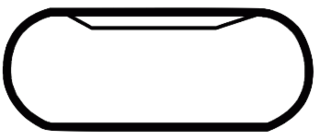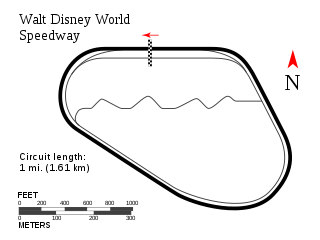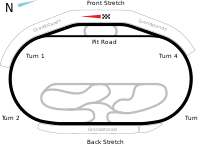
The 2006 IRL IndyCar Series began on March 26 and concluded on September 10. Sam Hornish Jr. won his third IndyCar Series championship. Hornish also won the 90th Indianapolis 500, passing rookie Marco Andretti on the final lap less than 500 feet (150 m) from the finish line. The title chase was very dramatic between Penske drivers Hornish and Hélio Castroneves battling Ganassi drivers Dan Wheldon and Scott Dixon. The four drivers occupied the first four positions in the final race at Chicagoland Speedway, with Wheldon leading Dixon home for a Ganassi 1–2, but Hornish finishing third, edging out reigning champion Wheldon on a tiebreak. Third would have been enough to catapult fourth-place finisher Castroneves to take the title, but he instead ended up two points behind Hornish and Wheldon. Dixon was also in strong title contention, finishing a mere 15 points adrift of the championship.

The 1996–97 Indy Racing League was the second season contested by the Indy Racing League. Tony Stewart was the champion, while Arie Luyendyk won the Indianapolis 500. The lengthy season was a result of the league abandoning the concept of ending each season with the Indianapolis 500. The 1996–97 season would ultimately consist of the two races that followed the Indy 500 in the calendar year of 1996, and all events contested in the calendar year of 1997. It also saw the introduction of a new chassis and engine package.

The 1998 Pep Boys Indy Racing League was one of relative stability compared to the previous two seasons. For the first time the season consisted of a single and complete spring, summer, and fall like all other forms of motorsport. 15 drivers completed the entire 11 race schedule, twice as many as the previous season. It was also the first complete season for the new Riley & Scott chassis, though it proved unpopular due to its late introduction. A. J. Foyt Enterprises drivers captured 4 wins, the Indy 500 pole, and the championship, arguably the most successful year in the team's history.

The 1999 Pep Boys Indy Racing League was highly competitive and parity was the order of the year. Team Menard had a very good season with their driver Greg Ray capturing 3 race wins in a row and the series championship. This was the last year before CART teams began to break ranks and jump to the IRL.

The 2000 Indy Racing Northern Light Series was another season that saw a high level of parity, as only one driver, champion Buddy Lazier, won more than a single race. It also saw the beginning of the jump from CART as Al Unser Jr. moved to the series full-time and Chip Ganassi Racing came over to run the Indy 500, which it won with driver Juan Pablo Montoya. It was also the final season for the Riley & Scott chassis, which also saw its first series win in 2000.

The 2001 Indy Racing Northern Light Series saw the addition of five races and loss of one to bring the total to 13. Chip Ganassi Racing returned to the Indy 500 with four cars and were joined on the grid by Penske Racing and Team Kool Green. Sam Hornish Jr. won 3 races on his way to the championship while the less consistent Buddy Lazier won four races on his way to second place in his title defense.

The 2002 Indy Racing League (IRL) was one of transition, with two reigning CART championship teams, Team Penske and Target Chip Ganassi Racing, joining the series with full time entries. The Oldsmobile engine was rebranded as a Chevrolet, and both Honda and Toyota announced their participation in the series starting in 2003 while Infiniti announced its withdrawal.

The 2003 IRL IndyCar Series brought some of the biggest changes in its history. The league adopted the name IndyCar Series, after a settlement with CART prohibiting its use had expired. Several former CART teams brought their full operations to the IRL, most notably major squads Chip Ganassi Racing and Andretti Green Racing, as well as former CART engine manufacturers Toyota and Honda, replacing Infiniti who shifted its efforts to the new feeder series Infiniti Pro Series. Many of the IRL's old guard including Robbie Buhl, Greg Ray, and Buddy Lazier had difficulty competing in this new manufacturer-driven landscape. The league also added its first international race this year, taking over the CART date at Twin Ring Motegi.

The 81st Indianapolis 500 was held at the Indianapolis Motor Speedway in Speedway, Indiana over three days, May 25–27, 1997. It was originally scheduled for Sunday May 25, however, rain washed out all activities for the day. The race was started on Monday May 26, but rain halted the race after only 15 laps had been completed. On Tuesday May 27, the race was resumed, and was run to completion. The rain delay, as well as two controversies, put a damper on the month. Arie Luyendyk won the race from the pole position, his second Indy victory. Treadway Racing, in only their second season of competition, finished 1st-2nd with Luyendyk and teammate Scott Goodyear. The team became the first to sweep the top two finishing position at Indianapolis since Leader Cards in 1962.

The 1996 True Value 200 was the first round of the 1996–1997 Indy Racing League. The race was held on August 18, 1996, at the 1.058-mile (1.703 km) New Hampshire International Speedway in Loudon, New Hampshire. This race was dominated, but not won, by Tony Stewart, who passed Arie Luyendyk on lap 15 and led 165 laps until he suffered an engine computer failure, with 18 laps to go and a nearly three-lap lead. 1996 Indy Racing League co-champion Scott Sharp went on to win the race.

The 1996 Las Vegas 500K was the second round of the 1996-1997 Indy Racing League. The race was held on September 15, 1996, at the 1.500 mi (2.414 km) Las Vegas Motor Speedway in Clark County, Nevada. It was the fifth and last race for the IRL in the year 1996, and, thus, the last under the frozen 1995 IndyCar regulations, before the arrival of the new chassis and engine formula for 1997. Richie Hearn was the winner of a race defined by its multiple crashes and high attrition, with nine lengthy cautions, 83 laps under yellow, a red flag and four drivers being extricated from their cars.

The 1997 Indy 200 at Walt Disney World was the third round of the 1996–1997 Indy Racing League. The race was held on January 25, 1997, at the 1.000 mi (1.609 km) Walt Disney World Speedway in Bay Lake, Florida, being the first IRL race of the calendar year 1997. It was the first race with the new chassis from Dallara and G-Force, as well as for the 4000 cc naturally aspirated engines supplied by Oldsmobile and Infiniti, and it marked the first time that a major open-wheel series contested a race with brand-new cars and engines. The race was won by Eddie Cheever after being called off on lap 149 of the scheduled 200 due to heavy rain.

The 1997 Phoenix 200 was the fourth round of the 1996–1997 Indy Racing League. The race was held on March 23, 1997, at the 1.000 mi (1.609 km) Phoenix International Raceway in Avondale, Arizona, and was won by the unheralded Jim Guthrie, who raced unsponsored, owing a big sum of money and having taken a second mortgage on his house. His win, beating IRL stalwart Tony Stewart after leading 74 laps, went down as one of the biggest upsets in the history of Indy car racing.

The 1997 VisionAire 500 was the eighth round of the 1996–1997 Indy Racing League. The race was held on July 26, 1997, at the 1.500 mi (2.414 km) Charlotte Motor Speedway in Concord, North Carolina, USA. The event was the first Indy Racing League event to be held at Charlotte.

The 1997 Pennzoil 200 was the ninth round of the 1996–1997 Indy Racing League. The race was held on August 17, 1997 at the 1.058 mi (1.703 km) New Hampshire International Speedway in Loudon, New Hampshire.

The 1997 Las Vegas 500K was the tenth and final round of the 1996–1997 Indy Racing League. The race was held on October 11, 1997 at the 1.500 mi (2.414 km) Las Vegas Motor Speedway in Las Vegas, Nevada.

The 1998 Indy 200 at Walt Disney World was the first round of the 1998 Indy Racing League season. The race was held on January 24, 1998 at the 1.000 mi (1.609 km) Walt Disney World Speedway in Bay Lake, Florida. As in 1997, rain hampered the event, this time forcing to cancel the qualifying session.

The 1998 Dura Lube 200 was the second round of the 1998 Indy Racing League. The race was held on March 22, 1998 at the 1.000 mi (1.609 km) Phoenix International Raceway in Avondale, Arizona.

The 1998 True Value 500 was the fourth round of the 1998 Indy Racing League season. The race was held on June 6, 1998, at the 1.500 mi (2.414 km) Texas Motor Speedway in Fort Worth, Texas.

The 2002 Delphi Indy 300 was an Indy Racing League (IRL) motor race held before approximately 50,000 spectators on September 8, 2002, at Chicagoland Speedway in Joliet, Illinois. It was the 14th of 15 scheduled rounds of the 2002 Indy Racing League and the second annual running of the event. Panther Racing driver Sam Hornish Jr. won the 200-lap race from pole position with the closest margin of victory in the IRL of 0.0024 seconds over Al Unser Jr. of Kelley Racing. Third place was Hemelgarn Racing's Buddy Lazier.













